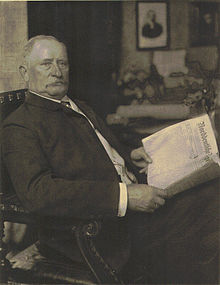Heinrich Ohlendorff

Heinrich Ohlendorff (born March 17, 1836 in Hamburg ; † July 3, 1928 there ; full name: Heinrich Jacob Bernhard Freiherr von Ohlendorff ) was a Hamburg merchant who was ennobled in 1873 and promoted to baron in 1889 , who shared in the second half of the 19th century rose to become the largest guano importer in the German Empire with his brother Albertus . He was also active as an investor and newspaper publisher and took on numerous honorary positions in his hometown.
Life


Ohlendorff was the son of the landscape gardener Johann Heinrich Ohlendorff and grew up in his house in the botanical garden in front of the Dammtor . After visiting the Johanneum and a private educational establishment, he completed a commercial apprenticeship and at the age of 20 joined his older brother Albertus' company as an authorized signatory . When it went bankrupt in 1857 as a result of a global economic crisis, Heinrich Ohlendorff founded his own company Ohlendorff & Co. and now took over his brother as authorized signatory and later as partner ("Associé"). The trade in guano from Chile, used as a fertilizer, brought both brothers a great fortune, which they both invested in extensive estates. In 1867 Heinrich initially leased around 12,000 acres of land in Volksdorf , Bergstedt and Sasel and two years later bought a 62,000 square meter plot of land in Hamm , on which he had the architect Martin Haller build a palace-like palace in the neo-renaissance style. In 1878 Haller built a summer house for Ohlendorff in Volksdorf.
When the guano business collapsed because Chile's nitrate emerged as an inexpensive alternative, Ohlendorff withdrew from the joint company in 1884 against the wishes of his brother and invested his fortune increasingly in real estate, for example in the construction of the Dovenhof , which opened in 1886, with an electric one Light, paternoster and other comfort facilities were considered the prototype of the modern office building in Germany. As early as the 1870s, the brothers had acquired the Norddeutsche Allgemeine Zeitung together with the Norddeutsche Bank . With these journalistic means they stood up for Bismarck's unification policy as well as Hamburg's customs union with the German Reich , for which they were both honored with the elevation to the baron class.
He was married to Elisabeth Ohlendorff and the marriage had ten children. According to him, which is Heinrich von Ohlendorff Road in the districts of Hamburg Volksdorf and Bergstedt named.
Awards
- March 18, 1872 Royal Crown Order III. Class.
- 1877 Franz Joseph Order , Commander in Chief.
- 1890 Order of Christ , Commander.
literature
- Karin von Behr: Heinrich Ohlendorff in: Hamburgische Biografie - Personenlexikon . Volume 2. Hamburg 2001, p. 305 ff.
- Karin von Behr: The Ohlendorffs. Rise and Fall of a Hamburg Family , Ed. Temmen, Bremen 2010.
- Hans Joachim Schröder: Heinrich Freiherr von Ohlendorff. A Hamburg businessman in the mirror of his wife Elisabeth's diaries , Hamburg University Press, Hamburg 2014 (online)
- Heinrich Jacob Bernhard Freiherr von Ohlendorff. A picture of life from Hamburg's heyday , compiled by Camilla Schmidt von Knobelsdorf, Hartung, Hamburg 1926.
Web links
- Literature by and about Heinrich Ohlendorff in the catalog of the German National Library
- Newspaper article about Heinrich Ohlendorff in the 20th century press kit of the ZBW - Leibniz Information Center for Economics .
- Jens Meyer-Odewald: The rise and fall of Hamburg's Buddenbrooks , history of Hamburg in Hamburger Abendblatt from April 6, 2010 ( digitized version )
Individual evidence
- ↑ Villa Ohlendorff, Schwarzestraße 1 , in: Wilhelm Hornbostel, David Klemm (ed.): Martin Haller. Life and work 1835–1925. Dölling and Galitz Verlag, Hamburg 1999, pp. 187–188.
- ^ Dovenhof , in: Wilhelm Hornbostel, David Klemm (ed.): Martin Haller. Life and work 1835–1925. Dölling and Galitz Verlag, Hamburg 1999, pp. 151–154.
- ↑ Royal Prussian Order List 1877 , First Part, Berlin undated, p. 636.
- ↑ Court and State Handbook of the Austro-Hungarian Monarchy for the year 1882 , Vienna undated, p. 168.
- ↑ Hamburg State Archives, 111–1 Senate, Findbuch 3 , Notices about awards of orders and medals, № 3854/5, p. 342
| personal data | |
|---|---|
| SURNAME | Ohlendorff, Heinrich |
| ALTERNATIVE NAMES | Ohlendorff, Heinrich Jacob Bernhard Freiherr von (full name) |
| BRIEF DESCRIPTION | Hamburg businessman and entrepreneur |
| DATE OF BIRTH | March 17, 1836 |
| PLACE OF BIRTH | Hamburg |
| DATE OF DEATH | July 3, 1928 |
| Place of death | Hamburg |
